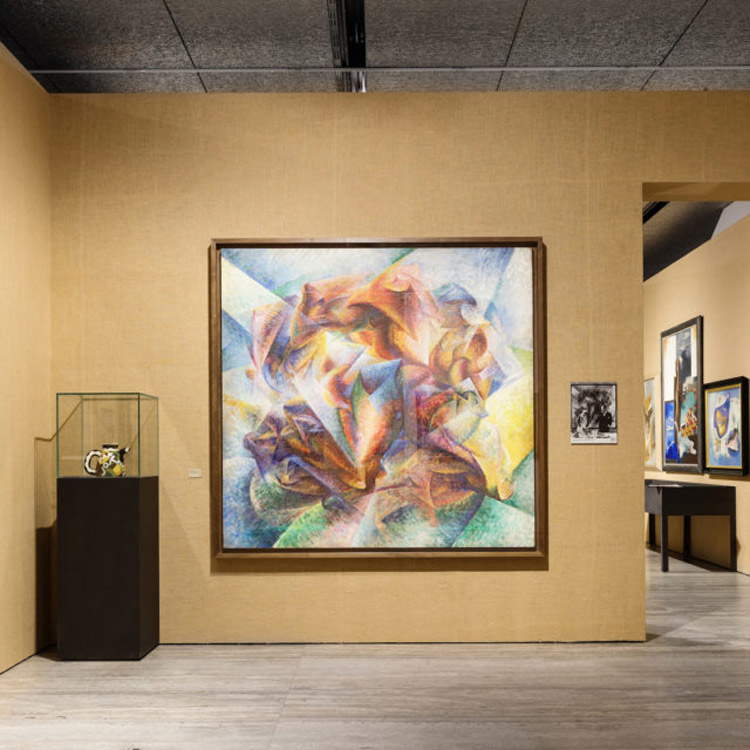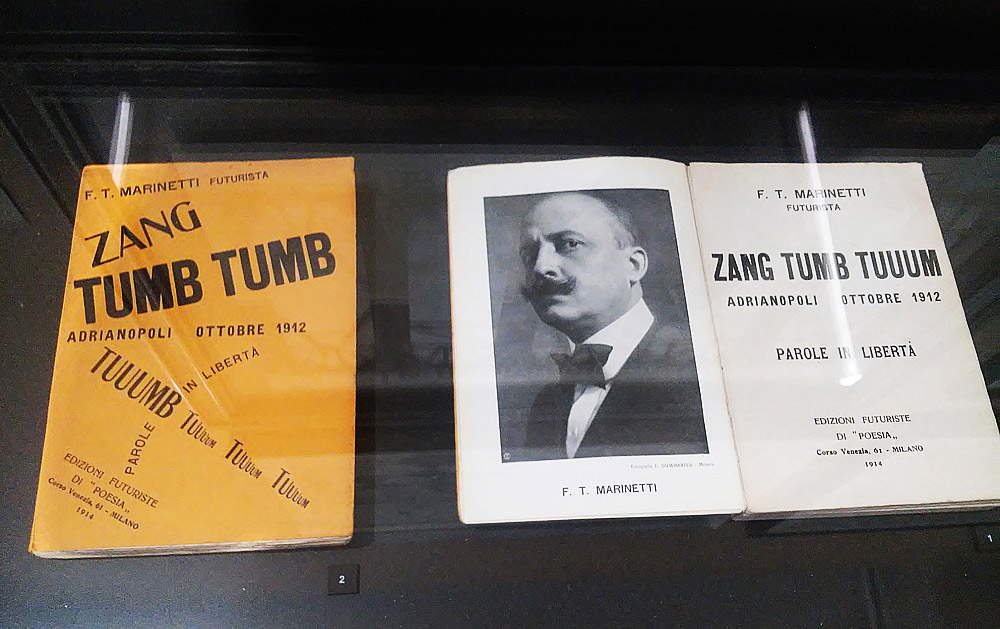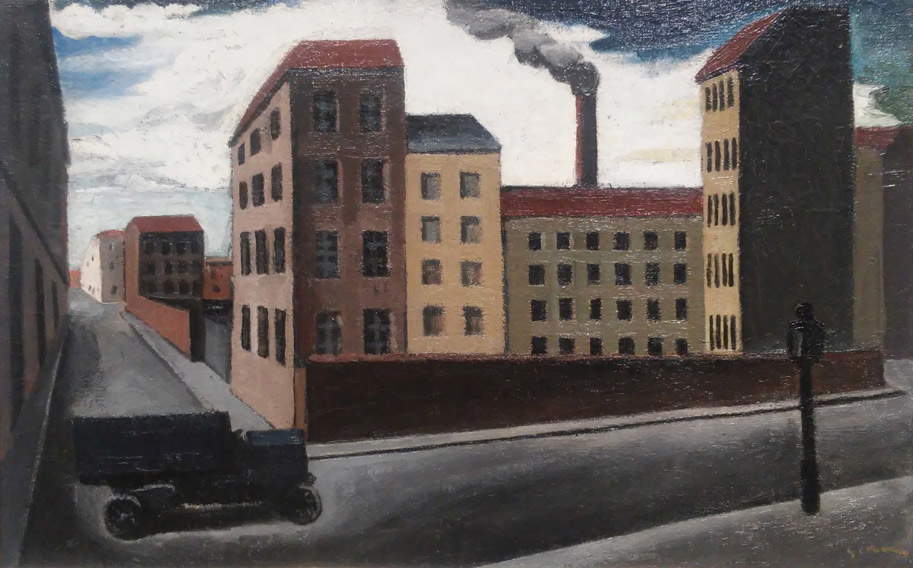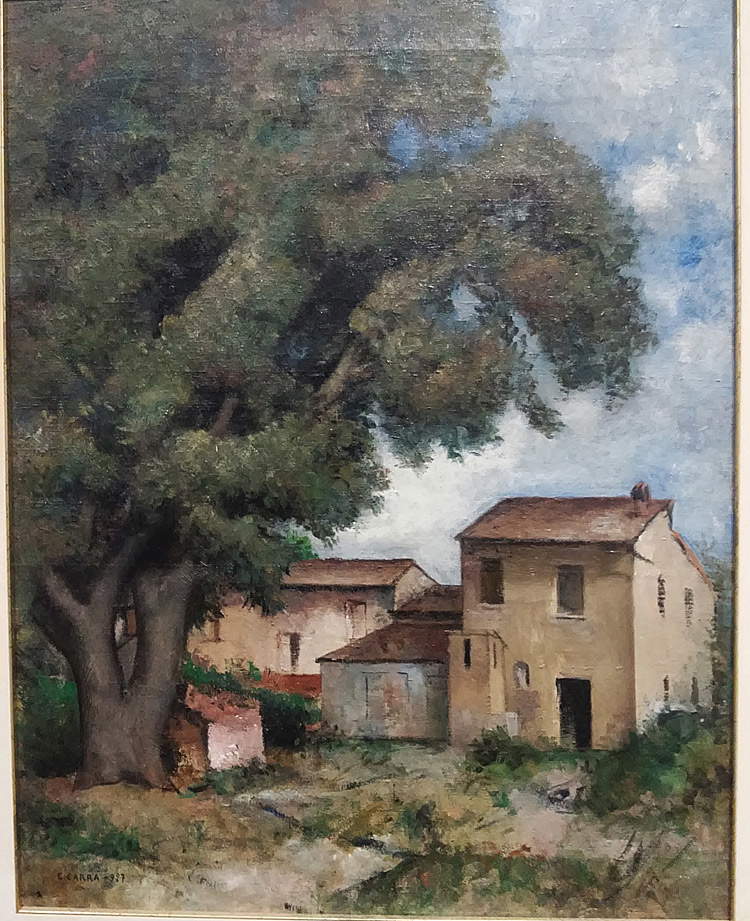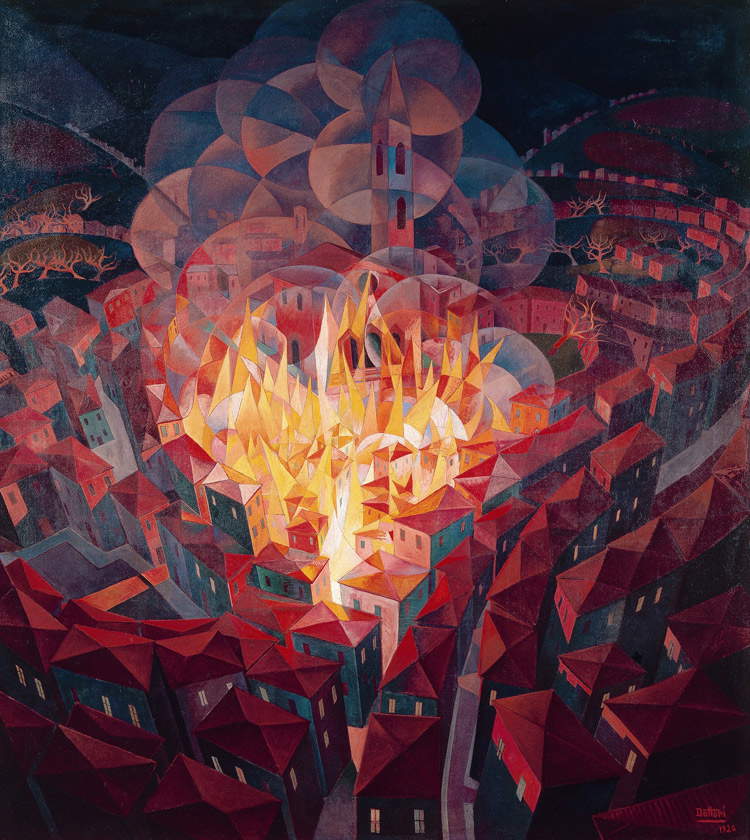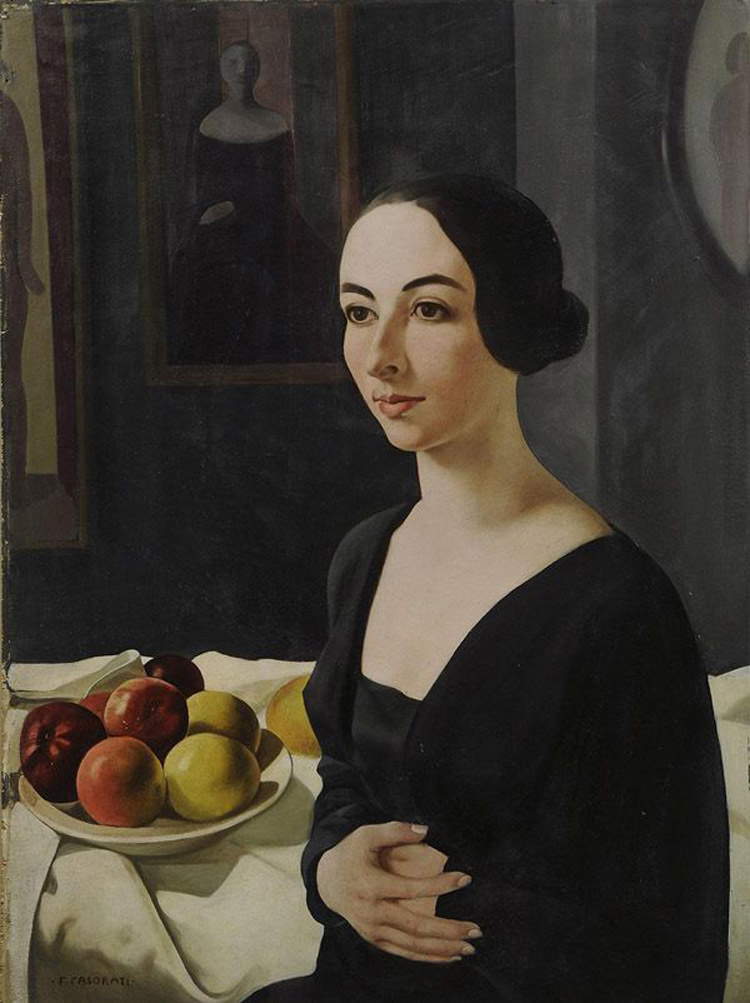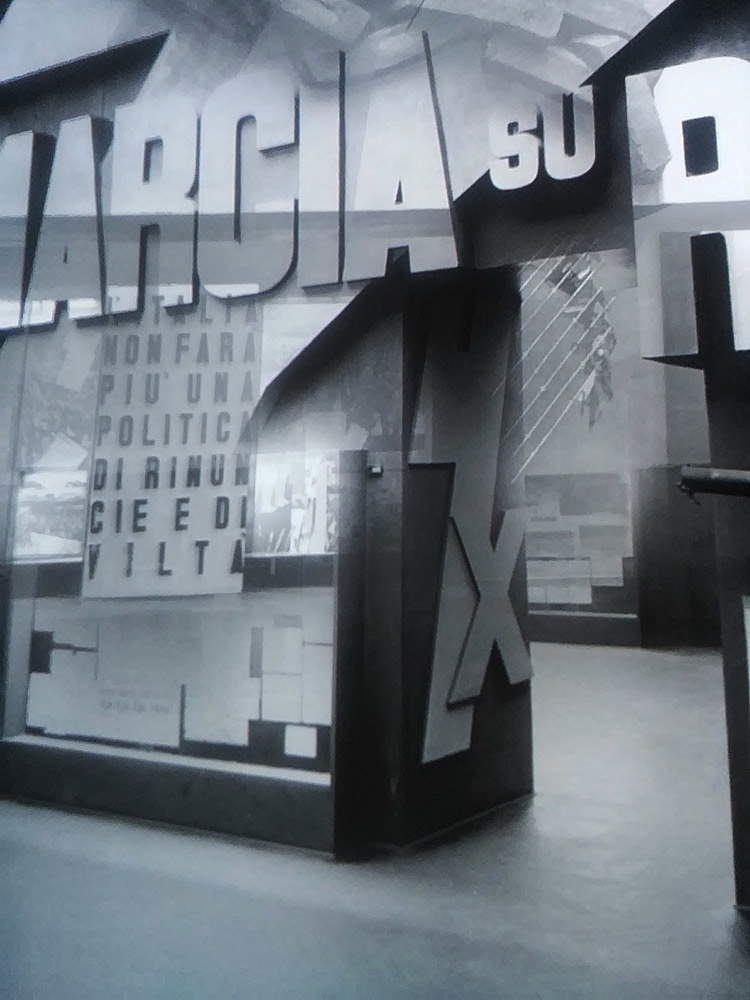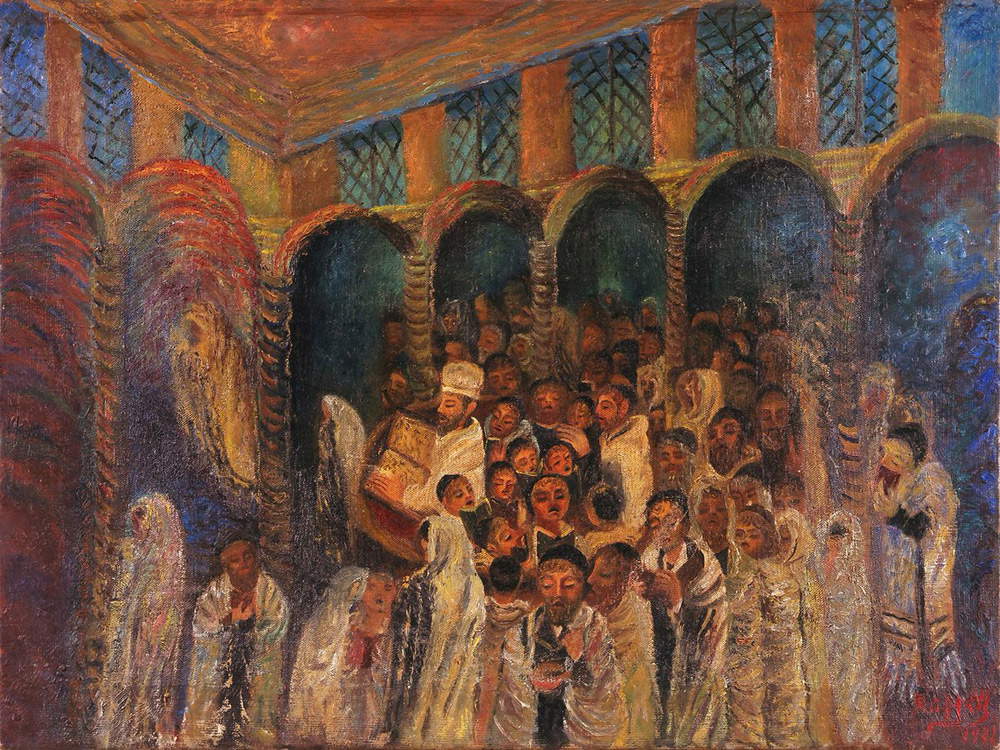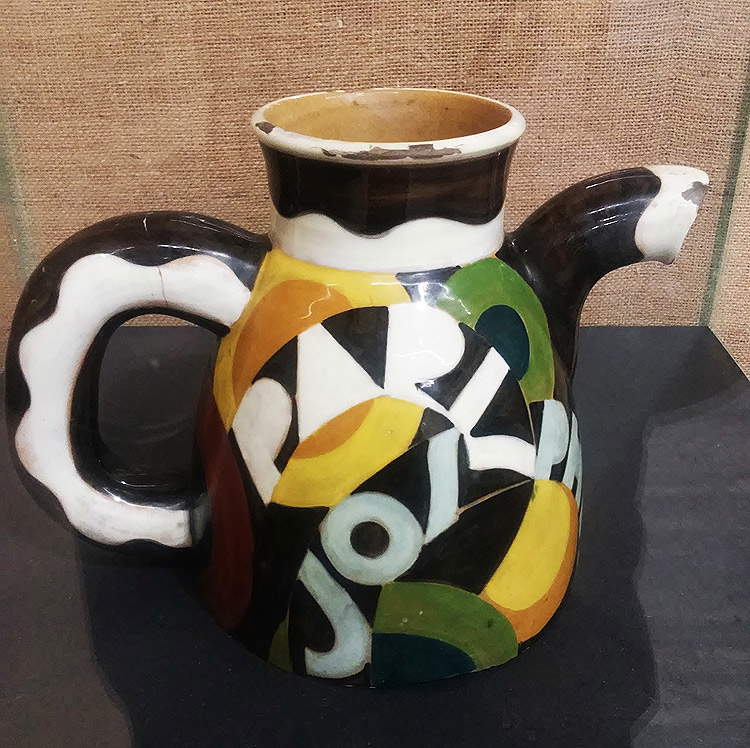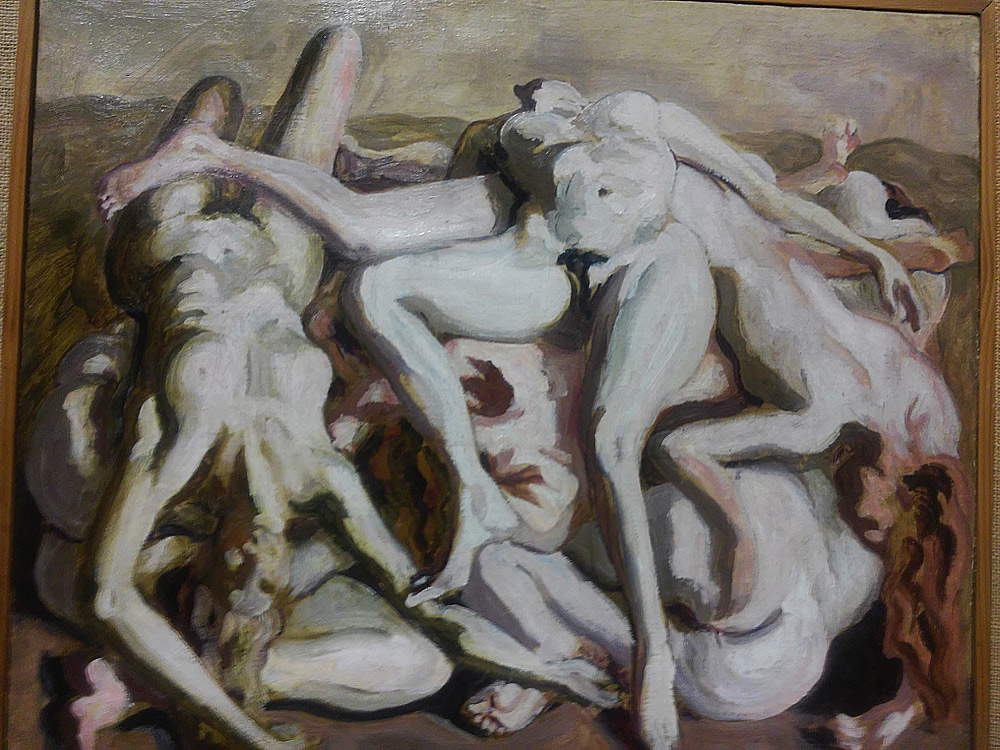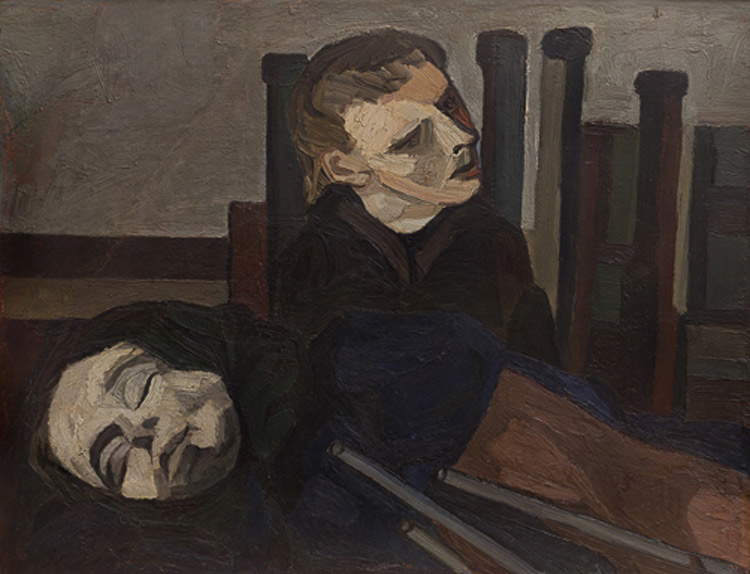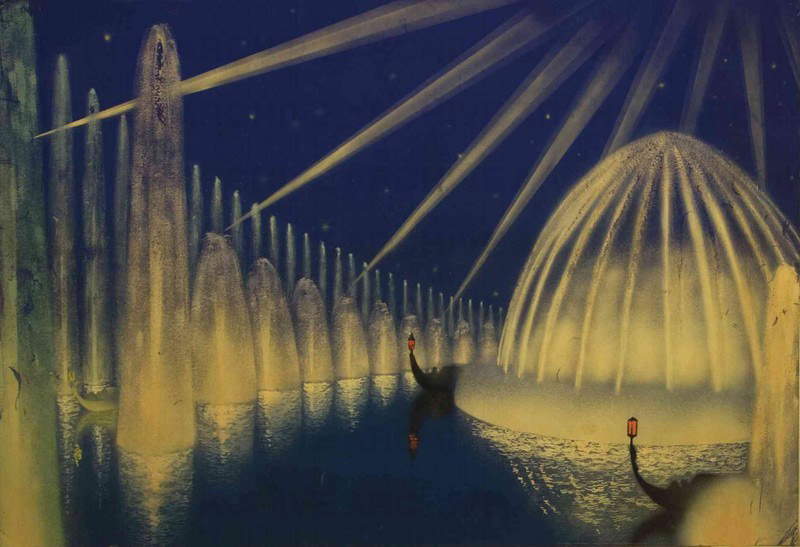by Federico Giannini (Instagram: @federicogiannini1), published on 02/05/2018
Categories: Exhibition reviews
/ Disclaimer
Review of the exhibition 'Post Zang Tumb Tuuum' in Milan, Fondazione Prada, February 18 to June 28, 2018.
To many it will have seemed excessive what art historian Ester Coen wrote a few days ago in Dagospia about Post Zang Tumb Tuuum. Art Life Politics: Italy 1918 - 1943, perhaps the most discussed exhibition of this year. Coen’s thesis, in essence, focuses on the fact that the suspension of the judgment of the curator, Germano Celant, who has “limited” himself to offering the public agluttonous parade of masterpieces (more than six hundred pieces, in a path dense with historical reconstructions that configure a philological operation of the highest value), fosters the danger of a distorted reading of the Milanese exhibition. To use the words of Ester Coen: “the diachronic and uncritical narration that unfolds room by room risks the misinterpretation of a historical moment that has known high points but then sank into an abyss of terror and cruelty. A terror that, however, is not breathed by moving between the singing of undisputed masterpieces for the indiscriminate adherence to an idea of beauty and apparent freedom disguised as the artistic political production of an era and a nation.” The critic, in short, has abdicated his role of judgment by setting up an operation as impressive as it is risky.
In fact, the exhibition, now on view at the Fondazione Prada in Milan until June 28, does not offer the public a critical reading: it merely proposes a rigidly and strictly chronological scanning, year by year, from 1918 to the World War years, with rooms that offer visitors precise, life-size reconstructions of exhibitions and environments of the time, and with the works placed exactly where they were, on walls occupied by large photographs that recreate the exhibition rooms of the time. A mammoth and spectacular operation, which in the long run, however, risks becoming repetitive, boring and tiring, not least because such an approach, if exercised on an exhibition aimed at investigating “the system of art and culture in Italy between the two world wars” (as per the programmatic objective stated in the introduction), necessarily entails at least a couple of problems. The first: it does not provide adequate answers about the relationship between artists and regime. It is necessary to read the catalog to know that, according to Celant, “the artist defends his linguistic autonomy while remaining indifferent to its instrumentalization”: in other words, the artists would have adopted positions of compromise, and it seems to read between the lines that adherence to fascism occurred (at least in most cases) out of mere opportunism. An opportunism that, however, did not prevent artists from expressing themselves in the language that was congenial to them, contrary to what happened in Hitler’s Germany or Stalin’s Russia, countries in which those who produced art were obliged to adapt to the canons established by the regime. In Italy this did not happen, due to the fact that Mussolini was convinced that the modernity of languages was functional to the birth of a new art, a fascist art. Not only that: the regime never provided the limits for establishing a definition of “fascist art.” Not least because Mussolini, to borrow a remark by Maurizio Calvesi, was fully aware that anything that stepped outside those eventual limits could widen the spectrum of dissent: “nothing is more difficult to govern than art,” Calvesi wrote, “and the regime knew it.”
Beyond the artists who adhered to fascism for reasons of opportunism, there were also those who instead adhered because they were motivated and moved by strong conviction and, on the opposite side, those who expressed open opposition. Thus arises the second of the problems alluded to earlier: the scant space that is reserved for anti-fascist artists (Mario Mafai, Carlo Levi, Ernesto Treccani, Corrado Cagli and others), who rise to the role of protagonists only in the closing lines. After all, it could not be otherwise: there can be no documentation on marginalized artists that has the same weight and size as that on artists who were instead in the regime’s good graces. And this is another aspect that plays into that risk of exaltation feared by Ester Coen. Having made these considerations, then, it is perhaps necessary to ask ourselves a question: in an age in which we are witnessing worrying regurgitations that, according to some, could foreshadow dangerous drifts, in an age in which we have not yet fully come to terms with our past, in an age in which it still seems impossible to touch on certain topics in a totally serene manner, are we really ready for an operation like Celant’s, an operation that suspends judgment and entrusts the narrative only to documents and figurative texts?
 |
| Hall of the Post Zang Tumb Tuuum exhibition at the Fondazione Prada in Milan. Ph. Credit Delfino Sisto Legnani and Marco Cappelletti |
 |
| Hall of the Post Zang Tumb Tuuum exhibition at the Fondazione Prada in Milan. Ph. Credit Delfino Sisto Legnani and Marco Cappelletti |
 |
| Hall of the Post Zang Tumb Tuuum exhibition at the Fondazione Prada in Milan. Ph. Credit Finestre Sull’Arte |
 |
| Hall of the Post Zang Tumb Tuuum exhibition at the Fondazione Prada in Milan. Ph. Credit Delfino Sisto Legnani and Marco Cappelletti |
It is, moreover, a tale that is difficult to summarize, since the visitor finds himself immersed in a bulimic exhibition, which leaves almost no respite to catch his breath, and which unravels over spaces that the Fondazione Prada typically reserves for at least three exhibitions. An exceptional amount, almost impossible to imagine in other exhibition venues. Here, therefore, we will proceed in brief, starting with the first rooms that introduce the public to the figure of Filippo Tommaso Marinetti (Alessandria d’Egitto, 1876 - Bellagio, 1944), who in 1914 published his visual poem Zang Tumb Tuuum, a synthesis of his research on words in freedom: a coherent start, not least because, after World War I, Marinetti was among the few of the original group of Futurists to carry forward with conviction the demands of the movement and not to give in to the return-to-order poetics that had instead fascinated others such as Carlo Carrà and Gino Severini. Marinetti is portrayed by Fortunato Depero (Fondo, 1892 - Rovereto, 1960) in his Marinetti temporale patriottico of 1924, in which the founder of futurism is depicted standing, dressed in black, engaged in an impassioned speech that comes out of his mouth in the form of a fiery tongue: a red wave that mingles with the white and green lightning bolts that strike the poet, making manifest the themes of his oration. In the collective imagination there is a tendency to identify futurist art with the art of fascism, yet the relationship between futurism and fascism breaks free from such rigid logic: suffice it to say that Marinetti himself, who had also founded the Futurist Political Party that later merged into Mussolini’s Fasci di Combattimento, already in 1920, in open polemic with the aspirations of the future Duce (he would have called him “a megalomaniac Mussolini who will become reactionary little by little”), decided to leave the Fasci. Again, three years later, Prezzolini affirmed that the revolutionary instances of Futurism were incompatible with a political program hinging on discipline and order, and in 1938, the year in which the racial laws were promulgated, Marinetti did not hesitate to express his disapproval of a policy whose devastating danger he had sensed.
These are, however, aspects that do not emerge from the exhibition, given its paradigm of mere historical reconstruction from which the figure of the curator is deliberately absent. The vision assumed by Post Zang Tumb Tuuum, rather, is functional in lowering the visitor within a synchronic perspective that allows him to appreciate, on one wall, the strength of the urban landscapes of Mario Sironi (Sassari, 1885 - Milan, 1961), eager to bear witness to the rapid changes to which the Milanese suburbs were heading, and not far away a reconstruction of the section reserved for Giorgio Morandi (Bologna, 1890 - 1964) at the Das Junge Italien exhibition at the Nationalgalerie in Berlin in 1921, at which the then 30-year-old Bolognese painter presented himself with his compositions of jugs and glasses that manifested that need to consider everything “with the tranquility of still life,” as a then very young Raffaello Franchi, just 19 years old, had to write in 1918 in the columns of La Raccolta. And again, the blatant propaganda of a work that is rhetorical but marked by a language that almost anticipates pop art such as Giacomo Balla ’s Le mani del popolo italiano (Turin, 1871 - Rome, 1958) is counterbalanced by the rappel à l’ordre of the placid Meriggio, of the idyllic Tramonto al mare and the tender Cavalli by Carlo Carrà (Quargnento, 1881 - Milan, 1966), painted in the same period, and exhibited in Milan next to the fierce and dramatic Incendio città by Gerardo Dottori (Perugia, 1884 - 1977), a work in which tongues of fire envelop buildings, decomposing their forms.
There is also room at the Fondazione Prada exhibition for private stories, such as that of Piedmontese entrepreneur Riccardo Gualino (Biella, 1879 - Florence, 1964), a refined collector of ancient and contemporary art and supporter of one of the greatest artists of the time, Felice Casorati (Novara, 1883 - Turin, 1963), present with his cold, detached portraits (those of Hena Rigotti and Renato Gualino are extraordinary), clear symptoms of that art that reacted “against the emphasis of programs hidden in reasoned justifications” by opposing “the instinct of painting and tradition,” as a then 22-year-old Piero Gobetti (Turin, 1901 - Neuilly-sur-Seine, 1926) wrote in 1923, in the first monograph devoted to Casorati. Casorati, Gualino, and Gobetti all three paid dearly for their proud and courageous anti-fascism: Gobetti with the violence of the squadrists that undermined his already precarious health (the young publisher would disappear in Paris at the age of twenty-five), Gualino with confinement and confiscation of all his assets, and Casorati with loneliness.
 |
| Filippo Tommaso Marinetti, two editions of Post Zang Tumb Tuuum |
 |
| Fortunato Depero, Marinetti patriotic storm (1924; oil on canvas, 150 x 100 cm; Private collection) |
 |
| The editorial staff of Futurismo with Mino Somenzi, Filippo Tommaso Marinetti, Enrico Prampolini, and Bruno G. Sanzin in Rome in 1931. On the wall, Fortunato Depero’s painting |
 |
| Mario Sironi, Urban Landscape with Truck (1920; oil on canvas, 50 x 80 cm; Courtesy ED Gallery, Piacenza) |
 |
| The reconstruction of the section on Giorgio Morandi at the exhibition Das Junge Italien |
 |
| Giacomo Balla, The Hands of the Italian People (ca. 1925; three enamel panels on canvas, 173 x 113.5 cm each; Private collection) |
 |
| Carlo Carrà, Il meriggio (1927; oil on canvas, 88 x 69 cm; Giorgio Pulazza Collection) |
 |
| Carlo Carrà, Sunset by the Sea (1927; oil on canvas, 49 x 57 cm; Venice, Musei Civici, Galleria Internazionale d’Arte Moderna di Ca’ Pesaro) |
 |
| Carlo Carrà, The Horses (1927; oil on canvas, 140 x 180 cm; Rome, Galleria Nazionale d’Arte Moderna e Contemporanea) |
 |
| Gerardo Dottori, Incendio città (1926; oil on canvas, 209 x 188.5 cm; Perugia, Museo Civico di Palazzo della Penna) |
 |
| Felice Casorati, Portrait of Hena Rigotti (1924; tempera on panel, 60 x 77 cm; Turin, Galleria d’Arte Moderna) |
 |
| Felice Casorati, Portrait of Renato Gualino (1923-1924; oil on plywood, 97 x 74.5 cm; Viareggio, Matteucci Institute) |
Having perhaps somewhat too hastily disposed of the section dedicated to Margherita Sarfatti, who perhaps would have deserved more space given her role as anundisputed protagonist of the cultural scene of the time, we come to the watershed of the Milanese exhibition, the Foundation’s depository, where the public is offered huge loop projections of images taken from the Central State Archives that recount the Fascist Revolution Exhibition, held in 1932 at the Palazzo delle Esposizioni in Rome: organized on the occasion of the tenth anniversary of the march on Rome, the exhibition saw the participation of all the artists “of fascism,” such as Sironi, Achille Funi, Enrico Prampolini, Giuseppe Terragni, and Adalberto Libera, who exhibited their works on nineteen rooms aimed at providing the public with a path intended to exalt the nation and its cult, fascism itself, and the figure of the duce. The Revolution exhibition turned out to be a huge success, since it attracted nearly four million visitors for a revenue that, at current exchange rates, would amount to nearly six million euros. Post Zang Tumb Tuuum thus continues along the lines of Fascist rhetoric: Depero and Balla return, reconstructions of the exhibitions promoted by the regime return, Thayaht’s sculptural synthesis arrives, sketches for Sironi’s celebratory frescoes make an appearance, and at one point period photographs of the protagonists of the time also appear. Every now and then the exhibition also gives space to the artists of dissent, reduced, however, to the role of mere comprimarî: parading here and there are works by Carlo Levi (condemned to confinement, which he would recount in the celebrated Christ Stopped at Eboli), Aligi Sassu (arrested), Antonietta Raphaël (affected by the racial laws), Mario Mafai (Antonietta Raphaël’s husband and thus also involved). Particularly interesting are the Yom Kippur in the synagogue by Antonietta Raphaël (Kaunas, 1895 - Rome, 1975) and the Flower Basket by Mario Mafai (Rome, 1902 - 1965), exemplifying the lyricism of the Roman school, which stood in sharp contrast to the rhetorical and monumental classicism of much of the art of the time. Other highlights of the exhibition include the presence of the very famous Dynamism of a Footballer by Umberto Boccioni (Reggio Calabria, 1882 - Verona, 1916), exhibited together with a ceramic by Tullio d’Albisola (Albisola Superiore, 1899 - Albissola Marina, 1971), since both works appear, in 1934, in the photo of Marinetti’s house in Rome.
The fall of the fascist regime and the atrocities of the war constitute the dramatic end of most of the cultural experiences of the time, as well as of the Fondazione Prada exhibition. A small oil on panel painting from 1943 by Mino Maccari (Siena, 1898 - Rome, 1989), Mussolini at the Great Council, from the DUX series, reduces the dictator to a grotesque and squalid caricature, while in the background are the tragedies of the world conflict recounted and witnessed in all their violence by paintings such as Concentration Camp, made in Florence by Carlo Levi (Turin, 1902 - Rome, 1975), who with dismaying insight foreshadowed a reality then unknown to most and that would emerge in all its horror only when hostilities were over, or like Civil War by Aligi Sassu (Milan, 1912 - Pollença, 2000), which depicts a group of partisans being shot, and again the touching Fucilazione by the antifascist Ernesto Treccani (Milan, 1920 - 2009), founder in 1938 of the magazine Corrente, suppressed just two years later. The futuristic plans for EUR, never completed according to the original design and still in the state of construction at the end of the world war, close the discourse as pale, faded shadows of the ambitions of a regime that ended up dragging an entire nation into the deepest abyss. And the final image of an exhibition held at the Palazzo Ducale in Genoa immediately after the Liberation, during which artists gave up their works to raise funds for the victims of the war, is probably the clearest and most glaring symbol of a possible rebirth.
 |
| Projections of the Fascist Revolution Exhibition |
 |
| Screenings of the Fascist Revolution Exhibition. |
 |
| Thayaht, Dux (1929; hunched metal, height 35 cm) |
 |
| Antonietta Raphaël, Yom kippur in the synagogue (1931; oil on canvas, 48.5 x 64 cm; Milan, Giuseppe Iannaccone Collection) |
 |
| Mario Mafai, The Flower Basket (1938; oil on canvas, 69.5 x 59 cm; Augusto and Francesca Giovanardi Collection) |
 |
| Umberto Boccioni, Dynamism of a Footballer (1913; oil on canvas, 93.2 x 201 cm; New York, Museum of Modern Art - MoMA) |
 |
| Tullio d’Albisola’s ceramic pitcher |
 |
| Carlo Levi, Concentration Camp or The Dead Women (Il lager presentito) (1942; oil on canvas, 50 x 61 cm; Rome, Fondazione Carlo Levi) |
 |
| Aligi Sassu, Civil War (I martiri di piazzale Loreto) (1944; oil on canvas, 116 x 200 cm; Rome, Galleria Nazonale d’Arte Moderna e Contemporanea) |
 |
| Ernesto Treccani, Fucilazione (1943; oil on canvas, Macerata, Fondazione Carima - Museo Palazzo Ricci) |
 |
| Carles Buïgas, Study for the “Luminous Gardens” project for E42 in Rome (ca. 1940; mixed media on charcoal; San Lazzaro di Savena, Massimo and Sonia Cirulli Foundation) |
One crosses the exit from the exhibition wondering if what the public was able to see in the last room is enough to ward off the risks of apologia, and if the gigantic rhetorical apparatus that moved more than one visitor to astonishment can succumb and be shattered by the heartbreaking images of murdered mothers, of young men shot, of lives brutally cut short in the lagers. The documentary paradigm with which the exhibition has been set up leaves any answer open, as indeed the often opposing reactions of those who have visited it show. For it may be thought that the document, as such, can deflate rhetoric with only the power of its scientific value, but also that the crude image can, on the contrary, provide grounds for exaltation. Is it therefore possible to observe with detachment a subject on which vivid ideological clashes are still being waged today? Is it sufficient to offer the public a series of artworks in settings that reproduce those of the time to enable visitors to understand the difficult relations between art and politics under a dictatorship? Can documents really speak for themselves, especially in the context of an exhibition intended for a large audience that is often not adequately educated on the themes of the exhibition and, indeed, expects to come away enriched? Or, does an exhibition such as Post Zang Tumb Tuuum set itself up as adangerous operation precisely because it is susceptible to different, even ambiguous, interpretations?
However, it is interesting that Germano Celant states that his real critical role was played, as he wrote in his essay in the catalog (a catalog, moreover, not very useful and excessively expensive: 110 euros, in the exhibition discounted to 90), “against exhibition decontextualization, with its practice of isolation, functional only to the ubiquity of mercantile value, whereby art is transformed into product and economy.” In other words, the critic openly speaks out against white cube displays and, therefore, against theabstraction of images from their context. The impact, it should be noted, is radically different from the exhibitions we are and have been accustomed to. Post Zang Tumb Tuuum thus also stands as an exhibition that intends to question the very practice oforganizing exhibitions. And this is perhaps the aspect that should be reflected upon, more so than the content aspect, also due to the fact that the Fondazione Prada’s exhibition adds practically nothing to our knowledge of interwar art. It is, in essence, the museographic value of Post Zang Tumb Tuuum that will continue to cause discussion and that has certainly indicated a path for new exhibition possibilities: in the model proposed by Celant, the works support each other, there are no pieces that prevail almost as fragments in themselves accomplished, but end up composing a choral narrative that is aimed at lowering the visitor into the reality of the period, rather than explaining or interpreting it. It is the triumph ofimmersiveness, which passes through the partial remakes, to use a cinematic term, of the exhibitions, biennials and quadrennials of the 1920s and 1930s. This, in short, is the main merit of the exhibition: to have proposed a new and different canon. This is probably what we will remember and this is what we will discuss in the years to come.
Warning: the translation into English of the original Italian article was created using automatic tools.
We undertake to review all articles, but we do not guarantee the total absence of inaccuracies in the translation due to the program. You can
find the original by clicking on the ITA button. If you find any mistake,please contact us.



